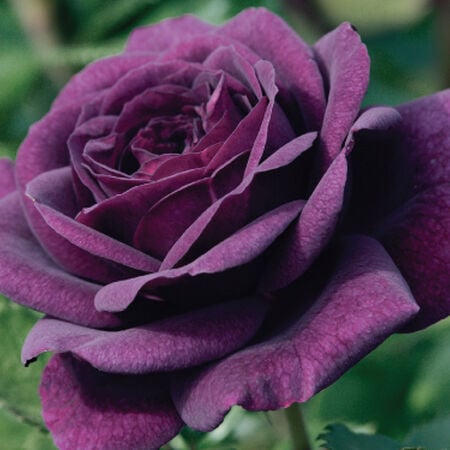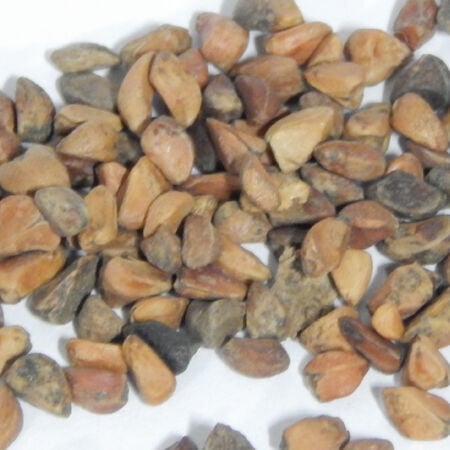Purple Bush, Rose Seeds
Key Attributes
Product Details
Weight
0.01Depth
0.15Height
4.5Width
3.25Plant Height
24-36"Botanical Name
RosaSeed Type
SeedAdditional Characteristics
Extended BloomsSeeds Per Gram
42Seeds Per Pound
19,200Packet
10 SeedsSow Depth
1/4"Seeds Per Ounce
1,200Breed
Open-pollinatedSun
Full SunUses
Cut FlowersLife Cycle
PerennialSow Method
TransplantCategories
FlowersDays To Maturity (# Days)
365Components
Growing Instructions
![]() Learning Download: How to Grow Roses
Learning Download: How to Grow Roses
Low Germination Rates: Even under the best circumstances rose seeds will have a low germination rate. Most varieties of roses will germinate between 20-30% of seeds. That means the majority of the seeds will not germinate. This is just part of the biology of rose seed production.
Before Planting: Rose seeds require stratification, or a cold and moist storage period, before they will sprout. Plant seeds 1/4 inch deep in a seed-planting mix in planting trays. Make sure the planting mix is moist, seal it in a plastic bag and place in the refrigerator for up to 10 weeks. After the stratification has passed, remove the trays and place them in a warm environment. Once the seedlings have sprouted, transplant them into individual pots.
Planting: Plant the roses outside in the spring and once they are established.
Watering: Water roses weekly close to the soil and not overhead to prevent fungal diseases.
Fertilizer: When the roses are established fertilize them each spring, but the application of a well-rotted manure each spring works just as well.
Days to Maturity: Roses may bloom once in May or June and then again in fall.
Harvesting: When cutting the roses, cut when the blooms are still formed and not completely open. Be careful of any thorns.
Tips: Pruning is another necessary tactic to produce the best rose bushes. Pruning take place in the spring when leaf buds begin to appear. To prune, make a cut 1/4 inch above the leaf buds and remove any twig-like branches.
Shipping Schedule
Our Seed Promise
 "Agriculture and seeds" provide the basis upon which our lives depend. We must protect this foundation as a safe and genetically stable source for future generations. For the benefit of all farmers, gardeners and consumers who want an alternative, we pledge that we do not knowingly buy or sell genetically engineered seeds or plants.
"Agriculture and seeds" provide the basis upon which our lives depend. We must protect this foundation as a safe and genetically stable source for future generations. For the benefit of all farmers, gardeners and consumers who want an alternative, we pledge that we do not knowingly buy or sell genetically engineered seeds or plants.
The mechanical transfer of genetic material outside of natural reproductive methods and between genera, families or kingdoms, poses great biological risks as well as economic, political, and cultural threats. We feel that genetically engineered varieties have been insufficiently tested prior to public release. More research and testing is necessary to further assess the potential risks of genetically engineered seeds. Further, we wish to support agricultural progress that leads to healthier soils, to genetically diverse agricultural ecosystems, and ultimately to healthy people and communities.
To learn more about the "Safe Seed Pledge" please visit www.councilforresponsiblegenetics.org.
Key Attributes
Product Details
Weight
0.01Depth
0.15Height
4.5Width
3.25Plant Height
24-36"Botanical Name
RosaSeed Type
SeedAdditional Characteristics
Extended BloomsSeeds Per Gram
42Seeds Per Pound
19,200Packet
10 SeedsSow Depth
1/4"Seeds Per Ounce
1,200Breed
Open-pollinatedSun
Full SunUses
Cut FlowersLife Cycle
PerennialSow Method
TransplantCategories
FlowersDays To Maturity (# Days)
365Components
Growing Instructions
![]() Learning Download: How to Grow Roses
Learning Download: How to Grow Roses
Low Germination Rates: Even under the best circumstances rose seeds will have a low germination rate. Most varieties of roses will germinate between 20-30% of seeds. That means the majority of the seeds will not germinate. This is just part of the biology of rose seed production.
Before Planting: Rose seeds require stratification, or a cold and moist storage period, before they will sprout. Plant seeds 1/4 inch deep in a seed-planting mix in planting trays. Make sure the planting mix is moist, seal it in a plastic bag and place in the refrigerator for up to 10 weeks. After the stratification has passed, remove the trays and place them in a warm environment. Once the seedlings have sprouted, transplant them into individual pots.
Planting: Plant the roses outside in the spring and once they are established.
Watering: Water roses weekly close to the soil and not overhead to prevent fungal diseases.
Fertilizer: When the roses are established fertilize them each spring, but the application of a well-rotted manure each spring works just as well.
Days to Maturity: Roses may bloom once in May or June and then again in fall.
Harvesting: When cutting the roses, cut when the blooms are still formed and not completely open. Be careful of any thorns.
Tips: Pruning is another necessary tactic to produce the best rose bushes. Pruning take place in the spring when leaf buds begin to appear. To prune, make a cut 1/4 inch above the leaf buds and remove any twig-like branches.
Shipping Schedule
Our Seed Promise
 "Agriculture and seeds" provide the basis upon which our lives depend. We must protect this foundation as a safe and genetically stable source for future generations. For the benefit of all farmers, gardeners and consumers who want an alternative, we pledge that we do not knowingly buy or sell genetically engineered seeds or plants.
"Agriculture and seeds" provide the basis upon which our lives depend. We must protect this foundation as a safe and genetically stable source for future generations. For the benefit of all farmers, gardeners and consumers who want an alternative, we pledge that we do not knowingly buy or sell genetically engineered seeds or plants.
The mechanical transfer of genetic material outside of natural reproductive methods and between genera, families or kingdoms, poses great biological risks as well as economic, political, and cultural threats. We feel that genetically engineered varieties have been insufficiently tested prior to public release. More research and testing is necessary to further assess the potential risks of genetically engineered seeds. Further, we wish to support agricultural progress that leads to healthier soils, to genetically diverse agricultural ecosystems, and ultimately to healthy people and communities.
To learn more about the "Safe Seed Pledge" please visit www.councilforresponsiblegenetics.org.






